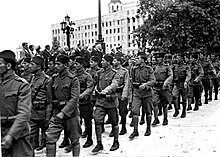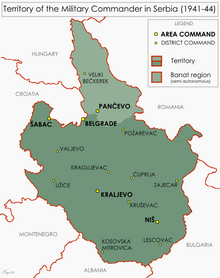Serbian State Guard
| Serbian State Guard | |
|---|---|
 Serbian State Guard | |
| Active | 1942–1945 |
| Allegiance | |
| Type | Gendarmerie |
| Role | Anti-Partisan operations |
| Size | 25,000–36,000 |
| Nickname(s) | Nedić's men Nedićevci |
| Engagements | World War II in Yugoslavia |
| Commanders | |
| Notable commanders | Dragomir Jovanović Milan Kalabić |
The Serbian State Guard (
History
Background
Following the
Formation

The Serbian State Guard (or SDS) was established by Nedić on the basis of an understanding he reached with the German Military Commander in Serbia,
Nedić intended that the SDS would not only maintain law and order and guard the borders, but also monitor the people's requirements and offer assistance and protection in areas such as "health care, cultural, educational and economic life".[11] The SDS was royalist and was rapidly infiltrated by Chetniks loyal to Draža Mihailović. It also lacked sufficient officers,[12] and although it had some initial successes, it never developed into an effective military force.[7][13] Meyszner took overall control of the SDS three days after its formation, a decision which was strongly opposed by Nedić.[8]
Operations
Along with other
In March 1942, Nedić suggested to the Germans that the SDK and Pećanac Chetniks be incorporated into the SDS and that he take control of the force, but this idea was firmly rejected.

By 1943, most of the rank and file of the SDS was sympathetic to Mihailović's Chetniks,[26] and SDS units were regularly being "disarmed" by them, sometimes even staging mock battles to disguise transfers of much needed weapons and ammunition to Mihailović's forces.[27][28] Jovanović himself provided financial assistance to Mihailović from his own discretionary funds.[29] In April 1943, units of the SDS were praised by German commanders for their fighting against the Partisans near Bijeljina in eastern Bosnia.[30] In June 1943, the Germans rounded up and executed 1,139 Serb civilians under suspicion that they had been collaborating with the resurgent Partisans. The SDS were involved in these crimes, and throughout 1943 were actively involved in committing atrocities against Serbian civilians.[31] After many delays, on 18 September 1943 Nedić met with Hitler in Berlin and was promised that he would be given command of the SDS and the SDK. Upon his return to Belgrade, Nedić called upon the Military Commander in Serbia, General der Infanterie Hans Felber, to make arrangements for the transfer of command, but Felber advised him that he had received no orders to do so. It was not until 2 November 1943 that Nedić was finally given command of both the SDS and SDK.[32] In late 1943 the SDS reached its maximum strength of 36,716 men.[9] By February 1944, the SDS leadership were avoiding any direct confrontations with Mihailović's Chetniks.[33]
In the spring and summer of 1944, the SDS had declined to a strength of around 24,000–25,000 men.[34] With the return of the Partisans to Serbia proper, the SDS began to incur serious casualties. For example, between 15 March and 15 August 1944, the SDS lost 157 men killed, 107 wounded and 26 missing.[35] During 1944, SDS started heavy repression in area around Leskovac, because of region's overwhelming support for Yugoslav Partisans.[36] Repression always included beatings and arrests in pro-Partisan villages, and in around half of the villages, Partisan supporters were executed and their houses were burnt down.[37] In late March, SDS unit of Mihajlo Zotović participated in anti-partisan action, alongside German forced and Albanian militia in 6 villages on Pasjača mountain. Part of population of the villages left with Partisans, so mostly women and children remained in them. During operation 9 women and 2 girls were killed, 9 more wounded and 80 more tortured, while razing 87 and robbing almost 200 houses. Witnesses claimed that only SDS troops participated in killing, torture and razing houses. This crime is different to most crimes of SDS, as majority of victims of the crime were women and children.[38] By August 1944, SDS units were responding to Mihailović's call for a general mobilisation by defecting openly to his Chetniks.[39]
According to report by state commission set by post-war authorities dated December 25 1945, SDS members killed 925 people, mostly men, outside combat, beat up over 8 thousand people, raped 117 women, arrested around 11500 people and razed 850 houses and other objects. While this report is methodologically flawed, it does represent the bases for research of crimes of occupiers and their collaborators in Serbia.[40]
Withdrawal and capture
Three days after the fall of the Nedić regime on 6 October 1944, Felber transferred the command of the SDS to General Miodrag Damjanović, the head of Nedić's secretariat and a principal confidant of Mihailović within Nedić's administration. Damjanović immediately placed himself and the remaining 6,500 troops of the SDS under Mihailović's command. The SDS was then renamed the "Serbian Shock Corps (Srpski udarni korpus or SUK) of the Yugoslav Army in the Homeland" once again under the command of Radovanović and it joined the withdrawal of other Chetnik formations towards the Sandžak region then into northeastern Bosnia. This arrangement resulted in a difficult and uneasy alliance which began to disintegrate under the pressures of the withdrawal.[41] SUK, alongside Chetniks and Muslim Militia, troops helped Germans take better positions in Sandžak, as they helped them take important towns from the Partisans in October 1944, allowing Army Group E to make retreat to Bosnia.[42] This collaboration is more shameful, considering that German forces committed atrocities against civilian population during this retreat, an example of which is a massacre of 30 civilians in Zalug near Prijepolje.[43]
In the last days of December 1944, the SUK participated, along with other Chetnik formations, in an unsuccessful attempt to capture the Partisan-held city of Tuzla in northeastern Bosnia. This failure and mutual recriminations between Mihailović's Chetniks and the SUK resulted in the effective disintegration of the SUK. By mid-January 1945, 5,000 former SDS members had rejoined the Germans, with some returning to Serbia to take advantage of Josip Broz Tito's amnesty. Most were transported to Austria where they were used in labour battalions under the direction of Organisation Todt, but about 1,500 were allowed to move to the Ljubljana Gap area, where they could join other collaborationist forces, such as the SDK or the Chetnik formations of Momčilo Đujić or Dobroslav Jevđević. Mihailović was not concerned about their departure, describing the former SDS troops as the "worst troops in the world".[44]
The remnants of the SDS/SUK and Mihailović's Chetniks remained under the overall command of Damjanović as part of the Chetnik Šumadija Division. These Chetniks had been under the command of the
Uniform and journal
The SDS wore either the 1940 pattern olive green uniform of the Royal Yugoslav Army, or the earlier Kingdom of Serbia pattern which was a green-grey in the case of officers, and a greyish-ochre colour for enlisted ranks. These were obtained from stores secured during the invasion.[47] The Review of the Serbian State Guard (Glasnik Srpske Državne Straže) was the official gazette of the SDS, published from 1942 to the end of 1943. The journal was edited by Jonić, and contributors included Nedić and Milan Aćimović.[48]
Ranks
Enlisted and NCOs [49]
- Enlisted Guard (Stražar pripravnik)
- Guard (Stražar)
- Corporal (Kaplar)
- Sergeant (Podnarednik)
- Staff Sergeant (Narednik)
- Sergeant Major (Narednik vodnik)
Officers [49]
- 2nd Lieutenant (Potporučnik)
- 1st Lieutenant (Poručnik)
- Captain (Kapetan)
- Major (Major)
- Lieutenant Colonel (Potpukovnik)
- Colonel (Pukovnik)
- Brigadier General (Brigadni Đeneral)
Footnotes
- ^ Hehn 1971, p. 350; Pavlowitch 2002, p. 141, the official name of the occupied territory was the "Territory of the Military Commander in Serbia".
- ^ Tomasevich 2001, pp. 63–64.
- ^ Tomasevich 2001, p. 64.
- ^ Tomasevich 2001, p. 177.
- ^ Tomasevich 2001, p. 179.
- ^ a b c d e Cohen 1996, p. 39.
- ^ a b c d Thomas & Mikulan 1995, p. 21.
- ^ a b c Ramet & Lazić 2011, p. 24.
- ^ a b Tomasevich 2001, p. 183.
- ^ Tomasevich 2001, p. 206.
- ^ Antić 2012, p. 22.
- ^ Pavlowitch 2008, p. 58.
- ^ Tomasevich 1975, pp. 109–110.
- ^ Pavlowitch 2008, p. 63.
- ^ a b Ramet 2006, p. 130.
- ^ Antić 2012, p. 31.
- ^ Haskin 2006, p. 29.
- ^ Ramet & Lazić 2011, p. 29.
- ^ Antić 2012, p. 18.
- ^ Antić 2012, pp. 32–34.
- ^ Ramet & Lazić 2011, pp. 29–30.
- ^ a b Ramet & Lazić 2011, pp. 32–33.
- ^ Ramet & Lazić 2011, pp. 24–25.
- ^ Pavlowitch 2008, pp. 98–99.
- ^ Tomasevich 2001, p. 215.
- ^ Pavlowitch 2008, pp. 185 & 199.
- ^ Tomasevich 2001, p. 216.
- ^ Pavlowitch 2008, pp. 96–97 & 183.
- ^ Cohen 1996, p. 40.
- ^ Cohen 1996, p. 57.
- ^ Ramet & Lazić 2011, p. 37.
- ^ Ramet & Lazić 2011, pp. 33–34.
- ^ Pavlowitch 2008, p. 226.
- ^ Pavlowitch 2008, p. 228.
- ^ Tomasevich 1975, p. 344.
- ^ Radanović 2016, p. 317.
- ^ Radanović 2016, p. 318-319.
- ^ Radanović 2016, p. 643-644.
- ^ Pavlowitch 2008, pp. 231–232.
- ^ Radanović 2016, p. 291.
- ^ Tomasevich 1975, p. 421.
- ^ Radanović 2016, p. 373.
- ^ Radanović 2016, p. 376.
- ^ Tomasevich 1975, pp. 435–436.
- ^ Cohen 1996, p. 60.
- ^ Pavlowitch 2008, p. 265.
- ^ Thomas & Abbott 2010, p. 34.
- ^ Stambolija 2011, p. 141.
- ^ a b Littlejohn 1994, p. 255.
References
Books
- Littlejohn, David (1994). Foreign Legions of the Third Reich. R. James Bender Publishing. p. 255. ISBN 978-0-912138-29-9.
- Antić, Ana (2012). "Police Force Under Occupation: Serbian State Guard and Volunteers' Corps in the Holocaust". In Horowitz, Sara R. (ed.). Back to the Sources: Re-examining Perpetrators, Victims and Bystanders. Evanston: Northwestern University Press. pp. 13–36. ISBN 978-0-8101-2862-0.
- ISBN 978-0-89096-760-7.
- Haskin, Jeanne M. (2006). Bosnia and Beyond: The "Quiet" Revolution That Wouldn't Go Quietly. New York: Algora Publishing. ISBN 978-0-87586-428-0.
- ISBN 978-1-85065-476-6.
- Pavlowitch, Stevan K. (2008). Hitler's New Disorder: The Second World War in Yugoslavia. New York: Columbia University Press. ISBN 978-1-85065-895-5.
- ISBN 978-0-253-34656-8.
- Ramet, Sabrina P.; Lazić, Sladjana (2011). "The Collaborationist Regime of Milan Nedić". In Ramet, Sabrina P.; Listhaug, Ola (eds.). Serbia and the Serbs in World War Two. London: Palgrave Macmillan. pp. 17–43. ISBN 978-0230278301.
- Thomas, Nigel; Mikulan, Krunoslav (1995). Axis Forces in Yugoslavia 1941–45. New York: Osprey Publishing. ISBN 978-1-85532-473-2.
- Thomas, Nigel; Abbott, Peter (2010). Partisan Warfare 1941–45. Wellingborough: Osprey Publishing. ISBN 978-0-85045-513-7.
- ISBN 978-0-8047-0857-9.
- Tomasevich, Jozo (2001). War and Revolution in Yugoslavia, 1941–1945: Occupation and Collaboration. Stanford: Stanford University Press. ISBN 978-0-8047-3615-2.
- Radanović, Milan (2016). Kazna i Zločin: Snage kolaboracije u Srbiji (in Serbo-Croatian). Belgrade: rosa luxemburg stiftung.
Journals
- Hehn, Paul N. (1971). "Serbia, Croatia and Germany 1941–1945: Civil War and Revolution in the Balkans". Canadian Slavonic Papers. 13 (4). University of Alberta: 344–373. JSTOR 40866373.
- Stambolija, Nebojša (2011). "'Glasnik srpske državne straže' - opšte informacije i tematska analiza sadržaja". Istorija 20. Veka (in Serbo-Croatian). 29 (1): 141–150. .
